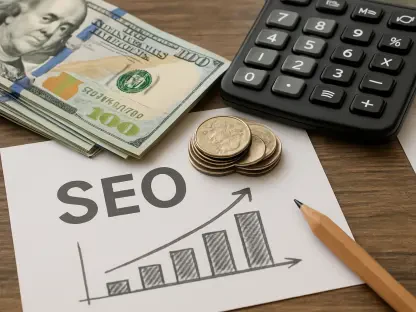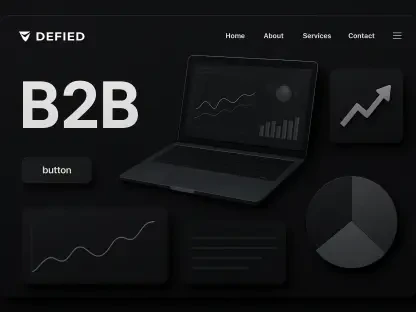In a world where every marketing dollar counts, tariffs have emerged as an unexpected disruptor, slicing through U.S. digital ad budgets with surgical precision, forcing companies to rethink strategies. Picture a major retailer, poised to launch a blockbuster holiday campaign, only to scale back due to skyrocketing costs from imported goods. This scenario is playing out across industries in 2025, as trade policies tighten their grip on corporate bottom lines. The ripple effects are undeniable, reshaping how brands allocate their advertising resources in an increasingly volatile economic landscape.
The significance of this shift cannot be overstated. With the Interactive Advertising Bureau (IAB) revising its growth forecast for U.S. digital ad spending to a modest 5.7%—down from an earlier projection of 7.3%—the stakes are higher than ever. Tariffs are not just a trade issue; they are a direct threat to marketing strategies, forcing companies to adapt or risk falling behind. This story delves into the heart of these challenges, uncovering why tariffs matter to every business reliant on digital reach and how the industry is responding to mounting pressures.
Tariffs and Ad Dollars: A Surprising Link
At first glance, tariffs might seem disconnected from the flashy world of digital ads, but the connection is stark and immediate. These trade policies, often aimed at protecting domestic industries, have driven up costs for imported goods, hitting sectors like retail and automotive particularly hard. As product prices climb, profit margins shrink, leaving less room for expansive marketing campaigns that once dominated online platforms.
This economic squeeze has created a domino effect. Businesses are now scrutinizing every expenditure, with advertising often the first to face cuts. A staggering 91% of ad buyers report that tariffs are directly impacting their budgets, prompting a reevaluation of how much can be invested in reaching consumers through digital channels. The result is a cautious approach, where every ad dollar must deliver measurable impact.
Beyond the numbers, this shift reflects a broader tension in the marketplace. Companies are caught between the need to maintain visibility and the reality of constrained resources. The unexpected intersection of trade policy and marketing strategy has turned digital advertising into a battleground for efficiency, where only the most agile players are likely to thrive.
Why Tariffs Are Disrupting the U.S. Digital Ad Market
Delving deeper into the economic undercurrents, tariffs are not merely a passing concern but a fundamental challenge reshaping the U.S. digital ad landscape. The increased costs of imported materials and products have placed immense pressure on industries reliant on global supply chains. For instance, a car manufacturer facing higher steel prices might slash its social media ad spend to offset losses, a pattern echoing across multiple sectors.
Consumer behavior is also evolving in response to these economic realities. As prices rise due to tariffs, purchasing power diminishes, leading to more selective spending habits. Marketers are noticing this shift, with many adjusting campaigns to focus on value-driven messaging rather than broad brand awareness. The IAB notes that second-half growth in digital ad spending has been further downgraded to just 5.0%, highlighting the severity of these combined pressures.
Moreover, the uncertainty surrounding trade policies amplifies the problem. Businesses hesitate to commit to long-term ad strategies when the economic outlook remains murky. This hesitation is evident in revised budget allocations, where short-term, performance-based campaigns are gaining favor over ambitious, long-range initiatives. The disruption is clear: tariffs are forcing a recalibration of how the digital ad market operates at its core.
Budget Cuts and Channel Shifts: Unpacking the Fallout
The impact of tariffs on digital ad spending manifests in varied and complex ways, with budget reallocations at the forefront. Many brands are pivoting toward channels that promise immediate returns, such as social media, which boasts a robust 14.3% growth rate, and retail media, up by 13.2%. Connected TV also shines with an 11.4% increase, while traditional linear TV plummets by 14.4%, signaling a decisive move away from older media formats.
Sector-specific challenges add another layer of complexity to this narrative. Import-heavy industries face the brunt of tariff-related cost hikes, leading to stark reductions in marketing outlays. For example, a consumer electronics firm grappling with pricier components might redirect funds from display ads to targeted search campaigns, prioritizing efficiency over reach. This trend underscores a growing divide between sectors able to absorb costs and those forced to cut back.
On a global scale, the contrast is striking. While U.S. digital ad growth has been downgraded to 9.5% by eMarketer, worldwide forecasts paint a rosier picture, with WARC projecting a 7.4% rise in global ad spend. This disparity reveals how localized trade policies are curbing U.S. momentum, even as other regions capitalize on digital expansion. The ad landscape is fragmenting, with tariffs acting as a critical dividing line between domestic struggles and international opportunities.
Industry Voices: Marketers Grapple with Uncertainty
Amid the tariff-induced turbulence, industry leaders are vocal about the challenges ahead. IAB CEO David Cohen captures the sentiment succinctly, stating that the market “hates uncertainty.” This aversion is pushing marketers to adopt flexible strategies, with many rethinking how to allocate limited resources in an unpredictable environment. The emphasis is on adaptability, a necessity when trade policies can shift overnight.
Survey data reinforces this cautious mindset, with 64% of marketers still prioritizing customer acquisition despite economic headwinds. Yet, the hurdles are significant—41% of buyers cite macroeconomic pressures as a barrier, while 40% point to changing consumer habits. These insights reveal a dual focus: capturing new customers while ensuring repeat purchases, a balancing act made harder by shrinking budgets.
The shift to a “trust-and-results” economy is palpable in these responses. Every campaign must now justify its cost through clear, quantifiable outcomes. A retail brand, for instance, might lean heavily on retail media networks to track conversions directly, abandoning less measurable channels. This pragmatic approach, echoed by many in the industry, highlights how tariffs are not just cutting budgets but reshaping the very philosophy of advertising.
Adapting to the New Normal: Strategies for Marketers
Despite the shadow cast by tariffs, marketers are not standing idle; innovative strategies are emerging to navigate these choppy waters. High-growth digital channels offer a lifeline, with platforms like social media and retail media proving their worth through strong performance metrics. Redirecting funds to these areas allows brands to maintain visibility without overextending financially strained budgets.
Agile budgeting has become another cornerstone of survival. Rather than locking into rigid annual plans, companies are adopting a more fluid approach, ready to pivot as economic conditions fluctuate. This flexibility is crucial when tariffs can unexpectedly alter cost structures. Additionally, focusing on measurable outcomes ensures that spending aligns with tangible results, a priority for justifying investments in uncertain times.
Balancing customer acquisition with retention efforts is also key. While acquiring new buyers remains a top goal, fostering loyalty through targeted campaigns can yield long-term value. For instance, personalized email marketing tied to past purchases can drive repeat business at a lower cost than broad ad buys. In this new normal, adaptability and precision are not just strategies but imperatives for staying competitive in a tariff-constrained market.
Reflecting on the Journey
Looking back, the journey through 2025 revealed how tariffs carved a challenging path for U.S. digital ad spending, forcing a recalibration of priorities across industries. The moderated growth, evident in the IAB’s revised 5.7% forecast, underscored the weight of trade policies on marketing decisions. Yet, amid these constraints, digital channels like social media and connected TV stood as beacons of resilience, guiding brands through the storm.
The road ahead calls for continued innovation and vigilance. Marketers must keep honing strategies that emphasize flexibility, channeling resources into platforms with proven returns. Exploring untapped digital opportunities, such as emerging programmatic tools, could further offset tariff pressures. The lesson from this period remains clear: adaptability is the currency of success in an ever-shifting economic landscape.
Finally, a broader perspective invites consideration of global trends as a source of inspiration. While U.S. markets grappled with localized challenges, the global uptick in ad spend signaled potential for cross-border learning. Embracing data-driven insights and fostering collaboration across regions could unlock new pathways for growth. The story of tariffs and advertising in 2025 was one of adaptation, and its legacy lies in equipping the industry for whatever challenges loom on the horizon.









